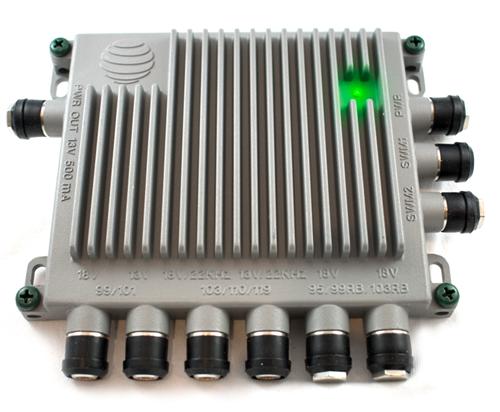DIRECTV’s dishes are the same whether you’re feeding a home or a high-rise. One dish can serve hundreds of apartments or hotel rooms, even though there are only six wires that come out of it. It may seem like magic but it’s simple science.
Here’s how it’s all done
There are two bits of technology that make this all possible. DIRECTV has three primary satellite locations. Some have more than one satellite. The problem is that your dish doesn’t really know that. It’s looking for signals based on where they are in space and the frequencies they occupy. There’s also a third criterion called “polarity” which (to make this really simple) explains how the signals “look” in 3 dimensions. A radio signal is really a sine wave but it can be “polarized” so it only works when looked at a certain way.
When a satellite dish receives signals, it breaks them up into one of four categories, each corresponding to a different set of satellite signals in the sky. Two different voltages are assigned and two of the signals have a 22kHz “tone” added to them, so there are four possible choices. Some satellites have a “reverse band” which is a second set of frequencies. There’s very little content there, but you still need to receive them. Most national HD signals are shifted to a low frequency (the so-called “B” Band) while SD signals and a few HD ones are shifted to a higher frequency (the so-called “L” Band.) This is done to make the best use of the coax cable’s capacity. Since every one of your channels belongs to one of those categories, only six wires are needed to serve every receiver.
In an old-school setup, the receiver has a lookup table, finds out which type of signal is needed and asks for only that signal. In a modern setup the request is made to the SWM multiswitch which is always receiving all six signals all the time.
It’s all about the splits

That’s the other part of the puzzle. You can split those six satellite lines from the dish as many times as you need. You just add amplifiers along the way. The thing is, you still have six lines. Plain splitters aren’t going to let you connect to hundreds of receivers but a multiswitch will. A multiswitch, like the one above, connects to all six lines all the time. It takes a request from a receiver for one of the four signals and sends it down the wire. A multiswitch like the one above can feed up to 30 receivers and can feed another multiswitch for 30 more. If you split a satellite line 8 ways (which is quite possible if you’re using multiswitches) that means 240 receivers.
These basic concepts are the core of DIRECTV’s apartment and hotel systems. And, that’s what sets DIRECTV so far apart from other systems like traditional cable TV which require expensive headend distribution. It’s what makes DIRECTV a winner!
Want to know more? Call us at 888-233-7563 during East Coast business hours. If it’s after hours, fill out the form below! We’ll get back to you!



